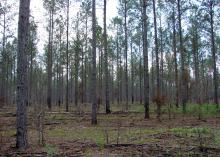Information Possibly Outdated
The information presented on this page was originally released on August 24, 2018. It may not be outdated, but please search our site for more current information. If you plan to quote or reference this information in a publication, please check with the Extension specialist or author before proceeding.
Pine forests provide wildlife habitat
STARKVILLE, Miss. -- Acres of pine forests cover Mississippi and the Southeast, but good forest management is not necessarily good wildlife management.
Too often, pine forests have solid ceilings of branches and needles that keep sunlight from reaching the forest floor. Grasses and leafy plants are unable to survive in this shade, so there is no food or shelter for deer, turkey, quail and other wildlife.
With some planning, landowners can increase wildlife populations in their forestland. Management practices, such as thinning, can benefit game species and songbirds while improving timber stand quality. Properties that lack grassy or leafy habitats will not be able to support much wildlife.
Reducing tree density is the first step in developing valuable grass and leafy ground cover. Thinning opens the forest canopy, allows more sunlight to reach the ground, and stimulates vegetative growth. In Mississippi, most pine species can be thinned for the first time around 15 years of age. Periodic thins may be necessary as trees continue to grow.
Thinning also can cause hardwood shrubs and trees to grow in the forest understory. If left unmanaged, these woody plants will also shade out the desired ground vegetation. Some form of periodic disturbance is necessary to control brush invasion.
Prescribed fire and disking are two disturbance tools that landowners can use to control understory hardwoods.
Thinned pine stands should be burned during winter to early spring. A controlled fire should always be conducted by a certified prescribed burn manager, who will develop a written burn plan and obtain the appropriate permits. Check with your local Mississippi Forestry Commission office for more information about prescribed burning regulations.
Light disking between thinned trees is another option, especially for sites with lighter brushy invasion. Use caution to reduce damage to pine tree roots and equipment.
Chemical control of hardwood sprouts may be necessary if hardwoods cannot be controlled by low-intensity prescribed fires or disking. Selective herbicides, such as imazapyr, can treat woody plants as well as invasive, nonnative vegetation, such as kudzu and cogongrass.
After disking, prescribed fire or chemical application, grasses and leafy vegetation will grow and provide nutritious food for rabbits, turkeys, deer, quail and other wildlife. It will provide nesting, loafing and escape cover that is not available on a forest floor blanketed with pine needles.
By planning some kind of soil disturbance on a two- to three-year rotation, landowners can develop a complex of different habitats. For example, they can create 60-acre or smaller burn units and burn one-third to one-half of each unit in year one. Another third or half is burned the next year and so on. This practice means that only a portion of the property is burned each year, while the other portions remain undisturbed. A rotational disking plan can also be developed in the same manner.
With forethought and planning, pine forest landowners can manage their property for timber and wildlife. Consultation with a wildlife biologist and registered forester can help landowners find a balance between wildlife and timber objectives.

Editor’s Note: Extension Outdoors is a column authored by several different experts in the Mississippi State University Extension Service.











